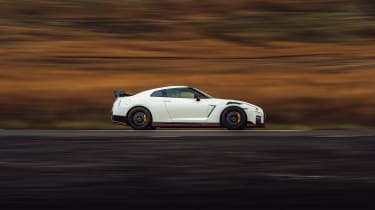Nissan GT-R Nismo (R35, 2014 - 2025) review – Godzilla on steroids is a Japanese icon
The R35 Nissan GT-R Nismo is the ultimate version of the ultimate Japanese supercar slayer, that the firm iterated on and improved over its life
The R35 Nissan GT‑R is archetypal of the kaizen philosophy of continuous improvement. That is to say, a car that’s been tinkered, tickled, nipped and tucked almost beyond all recognition. The original of 2007 and the very last, most extreme Nismo, are separated by £120,000 (not including inflation) in terms of list price, and 120bhp, on top of the myriad incremental changes that occurred over its 15 years on sale.
The GT‑R Nismo arrived first in 2015 in both a normal and high-downforce ‘N-Attack’ spec that bagged the 7.08.679 Nürburgring time. It was overhauled visually inside and out for 2017 in line with the overall GT‑R facelift, with GT3-spec turbos and a new more aggressive front facia. The 2020 update meanwhile featured downforce-generating arch vents, more compliant suspension, new lightweight wheels (1.1kg lighter than the original’s six-spoke items), carbon brakes and an uprated titanium exhaust.
Globally, the GT‑R story didn’t end in 2022, with a second comprehensive facelift for the 2025 model, mainly for Japan and the US. For us, G3 GRR represents the last iteration of Nismo GT‑R UK dealers ever supplied. Since its discontinuation, the R35 GT‑R Nismo demands consideration not as a contemporary competitor in 2025’s super sports car and supercar segments, but as next in line for Japanese icon status.
More reviews
Group tests
In-depth reviews
Reviews
We’ve been lucky enough to spend plenty of time in this very car, driving it in cities, against rivals, on track and here on some of the best driving roads we know in the British Isles, most recently in the North York Moores.
One thing is for sure: few cars have such physical presence. GT‑Rs have always looked tough, Nismos tougher still, shouldering their way into any parking area, their bulky, chiselled physique dominating the space around them. Outsized features such as the quartet of dinner-plate-sized tail lights and matching bazooka tailpipes lend it a cartoonish look. The original R35 Nismo was far from subtle, but the 2020+ Nismo adds its exposed carbon and aggressive aero changes, to leave no doubt of the seriousness of its purpose.
Its European contemporaries might look as sophisticated as Fleming’s Bond ordering a martini, but the GT‑R has an air about it that makes it more Jack Reacher walking into a bar fight. It operates in a different sphere to its contemporaries, too.
> Waving goodbye to the R35 Nissan GT‑R and Renault Mègane RS
Once the top of a healthy Japanese performance car tree, it was the last titan standing on a barren trunk with only a few compatriots for company. The days of Impreza and Evo varieties of all sorts hanging from every branch are gone, Toyota’s GR Yaris, which makes Nissan and Nismo’s commitment to the cause even more honourable, especially so when you consider Nissan isn’t exactly in a healthy condition right now. That it continued to direct resources for so long to a 592bhp, four-wheel-drive performance car that bears next to no resemblance to anything else in its line-up is more than commendable. It’s bloody inspiring.
Despite a design that’s heading into its teenage years and is as familiar as that of any rival of equal iconic status, you approach a GT‑R that wears the full Nismo battledress with a degree of apprehension. It’s in the same league as a 991.2 GT2 RS, 620R or AMG GT R Pro when it comes to palm perspiration levels. Bravado is very quickly replaced with modesty, with what lies beneath this Nismo’s carbon skin running faster through your mind with every step closer you take to it.
As with rivals that focus on driver involvement and ultimate performance, lightness has been added in the form of carbonfibre, here for the bonnet, bootlid, roof, bumpers and front wings, with cuts that add 6.8kg of downforce. It’s these details that are what set the Nismo apart and lend it such appeal. It’s a GT3 RS, but with added mystery. Those carbon panels – roof, bonnet, bumpers and front fenders – contribute a 10.5kg weight loss to a total weight saving of more than 30kg. The remainder is achieved with the help of everything from carbon brakes, which are 16.3kg lighter, to the set of 20-inch forged Rays alloys that shave a further 100g (count ’em!) from the kerb weight of 1703kg. The 2015 car was 1720kg, which itself dropped just 20kg on the standard GT‑R.
The dimpled alloy lollipop door handle is a surprisingly delicate detail on the otherwise hulk-like Nissan. Push the trailing end and the leading end pops out. Pull it and you open the door on an appealing and surprisingly conventional interior. It’s not a sophisticated noise when you pull the aluminium door closed. The combination of the Nismo’s lighter-than-expected construction and its dated fixtures and fittings will come as a shock to those used to Europe’s latest premium performance products. The cabin update of the facelift with a new wheel, improved materials and revised interfaces only went so far to keep the GT‑R contemporary. Swathes of Alcantara and contrast stitching lift it beyond the more efficiently austere cockpits of, say, a Porsche GT3 or Audi R8.
The Recaro seats pinch, hug and hold you in all the right places. though you sit a fraction high, or rather don’t drop low enough into the body of the car. Once you’ve (manually) adjusted the steering wheel you’re nicely supported by the deeply sculpted yet generously cushioned seat. The MY25 Nismo, incidentally, gets new Recaro Podium bucket seats.
Should you value tech and touchscreens over 592bhp V6 motors and Dunlop SP Sport Maxx GT 600 tyres that have had their outer tread grooves removed to increase the contact patch area, you’ll probably get straight back out again. There is Apple CarPlay, but really that shouldn’t be your focus here.
But this has always been the case with the GT‑R: you either get it or you don’t. Many don’t and buy a 911 instead, and while Porsche’s perennial sports car has been an ever-present rival to the R35, the two couldn’t be more individual. Only in recent years has the GT‑R, in Nismo trim, come close to the 911 RS models, and even then it sits somewhere between the naturally aspirated GT3 RS and the demonic GT2 RS in character and performance.
You’re unlikely to find someone who would dispose of either Porsche to own the Nismo, but there are also those who wouldn’t give the 911s a second glance on their way to buying a GT‑R. That Porsche launched and facelifted two entire generations of 911 Turbo before introducing a third in the time the R35 has been in production you can view in two ways: either Nissan is a little slow on the take-up and is milking the R35 for all it can, or it still doesn’t consider the project finished and has yet more to come. I’m firmly in the latter camp.
The straight-talking twin-turbo V6 doesn’t sugar-coat the process of burning 98 octane and oxygen. Its starter button requires you to depress it a fraction longer than in more modern machinery and the result is as far a cry from an augmented amplified sound as you can get, as it chunters into life with an agricultural clatter. The GT‑R was considered to have a rough edge to its mechanical soundtrack in 2008 and time hasn’t smoothed those vocal cords one bit. And it’s all the better for it. Stone cold on a dawn autumn morning it has the gravelly tone of someone who spent the night with a bottle of bourbon and one too many packets of Marlboro Reds.
The chunky gear selector takes some effort to slot through its zigzag gate and there are more mechanical noises when you select drive. The lack of refinement was always a slight shock; it’s now more charming than a failing, but some might find it off-putting.
It’s in and around the hand-built VR38DETT V6 engine that so much work was done on this Nismo versus the original 2015 car. It develops 592bhp – up from the original 2007 GT‑R’s already ample 473bhp but only 1bhp compared to the first R35 Nismo – and features low-inertia turbochargers taken straight from the GT3 race car.
> Honda NSX (2016-2022) review – Japan's answer to the Porsche 911 Turbo
Once you’ve eyeballed every temperature gauge offered (there remains one for everything that has a fluid passing through it) you start to explore the throttle’s travel. There’s some lag – it’s to be expected – but there’s also less of it, and even on small throttle inputs the GT‑R fills its lungs and heaves down the road with that trademark punch that has you involuntarily tensing as you would if you knew someone was about to leave their size-nine footprint on the small of your back. Some things never change.
Very much changed were the 2017+ Nismo GT‑R’s sharpened response times. The race car’s turbos make do with ten vanes rather than 11 and they are all 0.3mm thinner, which results in a near 15 per cent reduction in mass, and inertia drops by nearly a quarter, combining to improve throttle response by as much as 20 per cent.
Away from the numbers it results in an almost instantaneous response to your throttle inputs once that slight initial lag is overcome. Their responses over those of a regular GT‑R, the previous Nismo and the short-lived Track Edition are more noticeable than you’d ever expect. Yet despite peak torque not arriving until 3600rpm, speed and revs pile on with a rabid ferociousness, and despite the timber it carries this GT‑R still moves across the landscape with McLaren-esque athleticism as it calls on all of its 353bhp per ton.
Then there’s the noise. The induction growl, the angry, guttural roar that echoes along the titanium exhaust before exploding into the atmosphere through blue-tinged quadruple exhaust pipes, the whine from the turbos – all of them assault your senses, fight for your attention, but still your focus remains pinned to the horizon as the Nismo claws you into its grasp and a steely resolve falls over you. If you only ever drove this GT‑R in a straight line and experienced its monstrous thump and lightning pace you’d be left short of breath but desperate for one more hit.
Chassis-wise, life in the 2020+ R35 GT‑R Nismo is marginally improved compared to the original. The Bilstein DampTronic dampers were retuned with 20 per cent less rebound and five per cent less compression, changes largely made possible by the reduction in unsprung weight, according to Nissan. The cut Dunlop tyres are a stickier compound with a reduced tread pattern that increases the contact patch by 11 per cent. A rounder shoulder profile puts more surface on the road under high lateral loads. Combined, these changes achieved a five per cent increase in cornering force and sharpened the GT‑R to its keenest edge.
It’s still not a softly sprung car, the Nismo GT‑R, even with the reduced front spring compression. Driven at low speeds, or at a steady motorway cruise, the GT‑R is happy to just make progress. On more relentlessly three-dimensional roads it’s a physical experience. The ride is punishing but the body control is immense. Like a boxer tensing their core to protect against body shots, the GT‑R uses what wheel travel it has to extraordinary effect. When you combine that with the raw performance of the blown six, the Nismo GT‑R magic catches you in its spell.
There are three suspension modes to choose from. The default is Normal, with R mode firming things up(!) and Comfort promising a little respite. Or at least that’s what you’d expect, but whenever you opt for the softest setting the GT‑R feels choppier, with the wheels struggling to remain in contact with the road.
There’s a degree of teeth-gritting required, but it’s worth summoning some fortitude, for if you commit to the GT‑R, it rewards with an otherworldly experience. It devours the road, deploying monster performance and extracting so much grip and traction you almost feel sorry for the tarmac. Retrace your steps and it wouldn’t be a surprise to find the surface bruised from having so much purchase pulled from it by the tyres.
A 992 Turbo S is the only car to come close to this style of delivery, but even that feels soft-edged compared to the Nismo, which goes into combat with the road like an MMA fighter. There’s a brutality to it that’s both awesome and alien to even the most hardcore European machinery. Yet it’s not thuggish. Nor is it digital, for despite the technology it’s a very analogue experience.
The R35’s personality is partly shaped by its bespoke Premium-Midship platform and innovative rear-mounted independent transaxle all-wheel drive. With the transmission, clutches plus the centre and rear differentials concentrated at the rear to help achieve a better weight distribution, the rear axle receives 100 per cent of the engine’s output (via a carbonfibre propshaft). Only during extreme acceleration and cornering is a portion of that torque then sent forwards, via a second propshaft, to the front axle to achieve a 50:50 torque split. Summoning extraordinary traction in all situations, it reinforces the GT‑R as the Marvel Comics superhero of the supercar world and leaves you breathless.
The steering feels light on first acquaintance but the slightly glassy feel fades rapidly as you get some heat into the Dunlops. Once all four corners are switched on, the GT‑R feels far more keyed-in and communicative, the directness and clarity that allowing you to position it in, through and out of a turn remains unique to the GT‑R. There will forever be sections of the internet dedicated to pulling apart the dynamics of the R35 as a point-and-squirt oaf with the tactility and involvement of a supertanker. These tend to be the views of those who have never driven an R35.
Squeeeeze the throttle deeper into the footwell, keep your grip on the wheel relaxed, let the inherently stiff body absorb any slack, and the Nismo flows with an unexpected delicacy, settling into a rhythm as you link the exit of one turn with the entry to another in ever shortening blinks of your eyes. What body roll there is remains measured and consistent, the Nismo settling on its Bilstein-supplied chassis with a precision that instils confidence and encourages you to explore deeper into the armoury on offer.
Perhaps the biggest surprise is how keenly the Nismo reacts and moves to your commands, especially so the front end, which works every millimetre of its Dunlops’ increased contact patches to generate more grip under higher loads.
In the dry you’ll need a commitment level that’s borderline reckless to breach traction, while in the wet and on poor surfaces there’s a level of grip that takes a few committed braking points and apexes for your grey matter to compute just how hard you can lean on the front axle into a corner and call upon the rear to get the job done on exit. It may lack the sophistication of today’s latest all-wheel-drive, 600bhp super sports cars but the Nismo GT‑R drips character from every piece of carbon that’s been thrown at it.
Dig deeper and you find yet more precision and composure, and soon the GT‑R has banished those early thoughts of a fidgety, rough-riding machine that made low-speed journeys so tiresome. You feel, sense and experience those trad R35 high points but with more clarity, polish and involvement. You could drive a cheaper, more accessible 992 Carrera S across the same road at a similar pace, but Japan’s warrior offers a more exciting, engaging and rewarding alternative drive. It’s a unique experience; no other car thrills and excites like a GT‑R. Never has, unlikely ever will.
The GT‑R’s precision and consistency is something to behold, its appetite for challenging roads all but insatiable. The brakes – huge 410mm front and 390mm rear carbon-ceramic Brembo discs – have sensational stopping power and a brilliantly firm and feelsome pedal. Given they have the formidable job of reining in this rampant 1703kg machine, such immense reserves of retardation are welcome. As is the deftness with which it can be modulated.
It hooks you in from the moment it takes its first lunge for the horizon and leaves you transfixed and addicted to its performance every time you experience the brutality of it all. It’s a physical and demanding car delivering a thrill we once craved and celebrated, and there’s every reason why we should still do so today.
Downsides? Well, clenched-fist damping aside, the Nismo places more emphasis on delivering at ten-tenths than almost any other stock car we know. It’ll do moderate speeds and humdrum roads, but it signals its annoyance with assorted transmission whines and chunters, and a general sense of sulky boredom.
Indeed the six-speed dual-clutch ’box is an especially aged component of the GT‑R Nismo’s makeup. Updated software has brought quicker upshifts and sharper downshifts in the most extreme R mode, and it needs them. Left in its regular mode the upshifts can’t keep up with the rampant acceleration, the delay between pulling a paddle for a downshift and the gear engaging measured in moon cycles. It’s a glaring chink in the GT‑R’s otherwise impenetrable armour.
What we said:
‘The staggering way the GT‑R gains speed is still mentally hard to process, but with the huge increase in body control there is less squat under acceleration than with the standard car, so it actually feels slightly less intimidating because you feel in sharper control.’ – Henry Catchpole, 2015.
‘This new one is still the old cheddar side of firm, no question. There is still a hefty jiggling and jittering over rough surfaces, but whereas in the old car every impact felt like you’d hit a square-edged kerb, now the initial collision has been softened just enough to take the wince-factor out of it.’ – Henry Catchpole, 2020.
Prices and rivals
At launch the GT‑R cost £52,900 in the UK. The first Nismo of 2014 was a shocker at the time at £125,000, or £50k up on the standard GT‑R of the time. The 991 GT3 of the time undercut it significantly and gave up very little in terms of outright speed. The sublime Aston Martin V12 Vantage S was also a strong rival on price and in terms of the experience, if not outright capability and pace.
The price rose to £150,000 for the 2017 update, then in 2020, £180,095 – a threefold increase over the original reflecting the extent of the Nismo’s modifications, extremely low build numbers and the GT‑R’s global reputation. Some will find that kind of pricing ridiculous, but Japanese fast cars have always divided the opinions of Western enthusiasts. It’s part of their appeal.
Beyond its jaw-slackening capability, the magic of the R35 is its originality, owing nothing to its forebears but the GT‑R name and a hardwired predisposition for monumental point-to-point pace. There’s no denying the GT‑R remains an acquired taste and a brave purchasing decision when you consider the other cars you can buy for this level of financial commitment. Especially when £45k gets you an original R35 and for an additional £20k, Litchfield will provide you with a 750bhp upgrade… Cost aside, however, the R35 Nismo GT‑R remains one of the great driver’s cars.
Will this be the last GT‑R? The extent of Nissan’s precarious financial situation (one with which many other marques are familiar at the moment) the subject of headlines as 2024 bled into 2025, even the most ardent enthusiast and GT‑R fanboy must understand the challenges Nissan faces. Such a wonderfully bespoke, niche and small-selling super sports car surely isn’t a priority.
Development of a bespoke Nismo-branded halo model using plug-in hybrid technology for global consumption, including the UK, has been rumoured for years. Whether an R36 comes to fruition, remains to be seen. For now, the R35 GT‑R Nismo will be missed, with every exposure heightening our affection for it.
Specs
| Engine | V6, 3799cc, twin-turbo |
| Power | 592bhp @ 6800rpm |
| Torque | 481lb ft @ 3600-5800rpm |
| Weight | 1703-1725kg |
| Power-to-weight | 353bhp/ton |
| 0-62mph | 2.8sec |
| Top speed | 196mph |
| Basic price (2020) | £180,095 |












